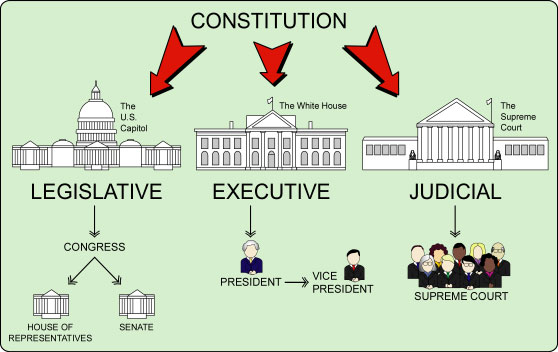|
The structure and functions of the legislative, executive and judicial branches of our national government. Determine constitutional qualifications and current office holders.
In our last lesson we analyzed the structure of the constitution and how it organized our national government.
The legislative branch makes laws. It is made up of Congress which is the name for two separate law making bodies, the House of Representatives and the Senate. They meet in the Capitol building on Capitol hill. Here is a link to your United States Congress: There was a debate at the Constitutional Convention about how states should be represented in Congress. The smaller states wanted a legislature with equal numbers from each state while the larger, more populous states, wanted representation to be based on a state's population. A compromise was struck so that there would be two houses of congress. The House of representatives (link) is based on population (currently with 435 members) while the Senate has two representatives, or Senators, from each state for a total of 100. Here's a video on the legislative branch:
Access this reading for the executive branch please. The executive branch of our national government enforces the laws enacted by Congress. At its head sits our President and his Vice-president. They are advised by a non-elected group called the Cabinet. The Constitution says nothing about a cabinet but our first president, George Washington, knew that the job was going to require the help and assistance of others so he started the precedent (tradition). Here's a video on the executive branch:
Access this reading for the judicial branch please. Our judicial branch interprets the laws as enacted by congress and enforced by the executive branch. It is made up of all the courts with their judges and justices. The constitution only specifically mentions the Supreme Court, (link) but later acts of congress established a federal court system. The U.S. Supreme Court consists of nine justices appointed for life by the President with the advice and consent of the Senate. One justice is appointed as the Chief Justice and has additional administrative duties related both to the Supreme Court and to the entire federal court system. The Supreme Court meets on the first Monday of October each year and usually continues in session through June. The Supreme Court receives and disposes of about 5,000 cases each year, most by a brief decision that the subject matter is either not proper or not of sufficient importance to warrant review by the full court. Cases are heard en banc, which means by all the justices sitting together in open court. Each year the court decides about 150 cases of great national importance and interest, and about three-fourths of such decisions are announced in full published opinions. The Supreme Court is located across the street from the U.S. Capitol Building in Washington, D. Here's a video on the judicial branch:
1. Qualifications to be a member of the House of
Representatives and length of the term they serve. There is a useful organization called "Vote Smart" (link) where you can look up all of you elected representatives in government. Go there and enter your address (you have to either know or look up your zip + four, but you can do that at this site). 7. Give me your name and address and then list the following information: Our current president, your two senators and your congressional representative (another way of saying your representative in the House of Representatives). Now visit the Supreme Court (link). 8. How many justices are on the court? Are
there any women justices? Any minority justices? |

